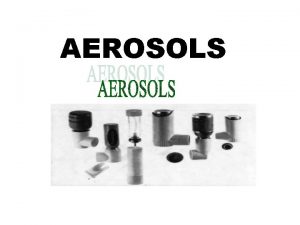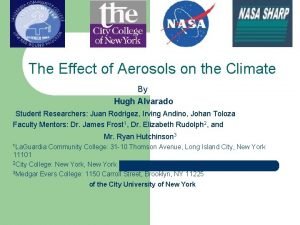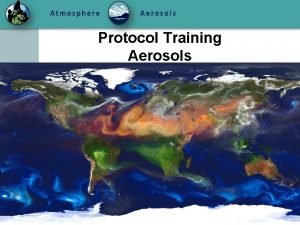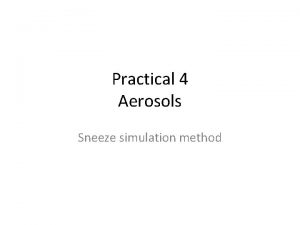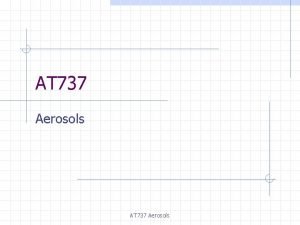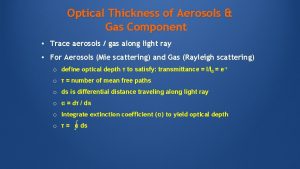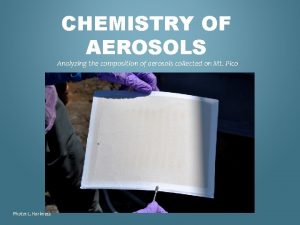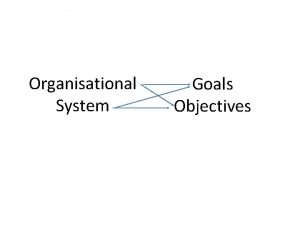Aerosols Protocol Aerosols Protocol Goals for the Training
















- Slides: 16

Aerosols Protocol

Aerosols Protocol Goals for the Training Session • Provide an inquiry context for the data collection and science content • Provide accurate science content • Review procedures for data collection • Review data entry and analysis • Discuss classroom implementation ideas • Collect feedback from participants

Aerosols Protocol Inquiry Context • How are aerosol concentrations related to changes in the seasons? • How can aerosols be used to tell where air comes from? • How does smoke from large forest fires affect sunlight reaching Earth’s surface? © National Center for Atmospheric Research

Aerosols Protocol Local Inquiry Example

Aerosols Protocol Why do GLOBE scientists research aerosols? • To provide ground-based data that assesses the performance of space-based measurements of aerosols • To add to data provided by satellite remote sensing • To help track the effects of dust storms, fires, volcanic eruptions, and pollution around the world • To add to knowledge scientists have about the energy cycle and the water cycle

Aerosols Protocol Science Content: What are Aerosols? • Solid or liquid particles suspended in the air Sources: • Natural: volcanoes, sea spray, dust, smoke, wind erosion, water droplets, ice particles, pollen • Human: plowing, surface mining, combustion © National Center for Atmospheric Research

Aerosols Protocol Science Content: Effects of Aerosols Photo taken by Carlye Calvin © University Corporation for Atmospheric Research • Too small to be seen individually (100’s – 1000’s nm) • They scatter visible sunlight: – The sky looks dirty or hazy – Creates brilliant orange and red skies at sunrise and sunset – Creates a large aureole around the sun or full moon – Some act as nuclei formation of cloud drops or ice crystals

Aerosols Protocol Science Content: Aerosols and Light Absorption • Sunlight includes a range of wavelengths • Aerosols and gases absorb and scatter light best at wavelengths that match their size • Both gases and aerosols absorb and scatter sunlight • If we know (1) atmospheric pressure, and (2) the elevation angle of the sun, we know the amount of gas between us and the sun • In the absence of clouds, any light absorption not caused by atmospheric gas is from aerosols

Aerosols Protocol Instruments: Sun Photometer • Aerosol Optical Thickness (AOT) can range from 0 (100% light transmission) to >5. 0 (<1% light transmission) • Sun photometers can be obtained from the GLOBE Scientists

Aerosols Protocol The Measurements • Maximum Voltage in Sunlight • Dark Voltage • Aerosol Optical Thickness (AOT) • Cloud Protocols • Current Air Temperature • Relative Humidity

Aerosols Protocol Collecting Data: Field/Lab Guides & Data Sheets Field/Lab Guides: • • • Checking and Changing Your GLOBE Sun Photometer Battery Lab Guide Aerosols Protocol Classroom Preparation Guide Aerosols Protocol Field Guide Cloud Cover and Contrail Cover Protocol Field Guide Cloud Type and Contrail Type Protocol Field Guide And one of the following: • Digital Multi-Day Max/Min Current Temperature Protocol Field Guide • Maximum, Minimum, and Current Temperature Protocol Field Guide And one of the following: • Digital Hygrometer Field Guide • Sling Psychrometer Field Guide Data Sheets: • Aerosols Data Sheet

Aerosols Protocol Collecting Data: Protocol • • • Select red or green channel (three measurements needed for each) Record maximum voltage reading Record dark voltage reading Record the precise time Observe and record cloud conditions, current air temperature, and relative humidity Ideally at a particular sun angle in the morning when the sun is visible

Aerosols Protocol Enter Data on the GLOBE Web Site Step 1: Be sure the atmospheric study site definition is completed Step 2: Select “Aerosols” from the atmosphere data entry menu Step 3: Enter date/UT time/select site/Sun photometer serial number Step 4: Enter collected data Step 5: Confirm data entries on verification page

Aerosols Protocol Looking at the Data

Aerosols Protocol Classroom Implementation • • Inquiry Curriculum/Standards Alignment Assessment Classroom Management

Aerosols Protocol Getting Started • The GLOBE Web site has information http: //www. globe. gov • GLOBE Help Desk or your Country Coordinator can support you as you get started. • Get your students involved doing real science!
 Strategic goals tactical goals operational goals
Strategic goals tactical goals operational goals Strategic goals tactical goals operational goals
Strategic goals tactical goals operational goals Aerosol is pressurised dosage form
Aerosol is pressurised dosage form Types of aerosols
Types of aerosols General goals and specific goals
General goals and specific goals Examples of generic goals and product-specific goals
Examples of generic goals and product-specific goals Design goals of transport layer protocol
Design goals of transport layer protocol Kontinuitetshantering
Kontinuitetshantering Typiska novell drag
Typiska novell drag Tack för att ni lyssnade bild
Tack för att ni lyssnade bild Returpilarna
Returpilarna Shingelfrisyren
Shingelfrisyren En lathund för arbete med kontinuitetshantering
En lathund för arbete med kontinuitetshantering Kassaregister ideell förening
Kassaregister ideell förening Personlig tidbok fylla i
Personlig tidbok fylla i Anatomi organ reproduksi
Anatomi organ reproduksi Densitet vatten
Densitet vatten


